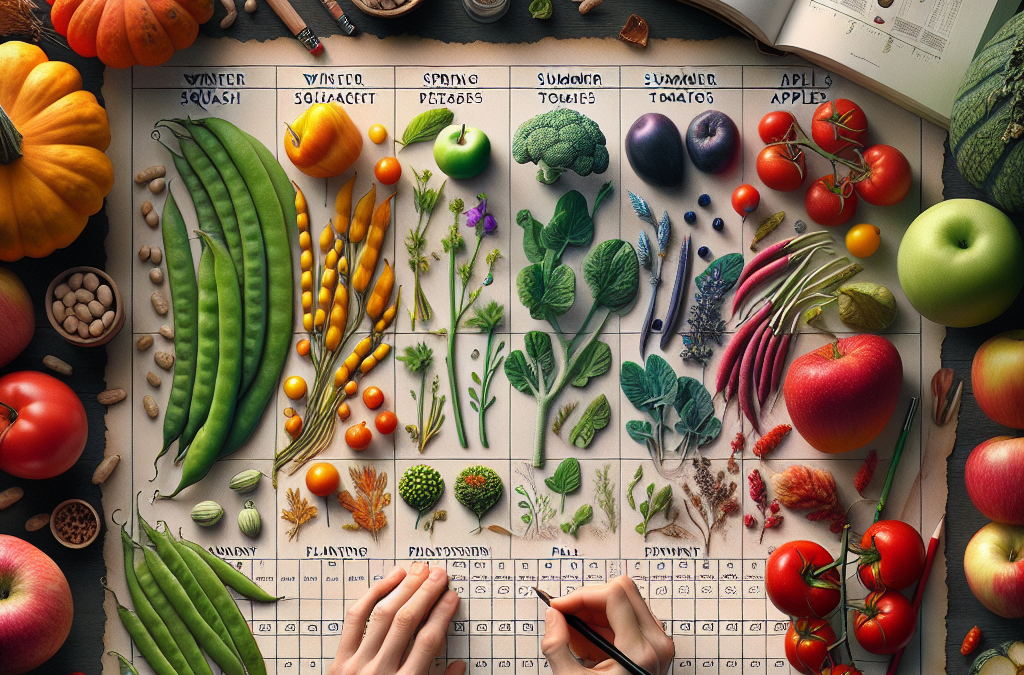Understanding Your Growing Zone
Discovering Your Zone
First things first, you’ve got to know what growing zone you’re in. This is where your local climate comes into play. Things like frost dates and average temperatures can vary massively based on where you are. I remember when I first started gardening and planted my tomatoes a bit too early – let’s just say, they weren’t too happy about the surprise frost!
To find your zone, I recommend checking out the USDA Plant Hardiness Zone Map. It’s super user-friendly! Just enter your zip code and voila, you’ve got your growing zone. Knowledge is power, folks, and this is the first step to a successful harvest calendar!
Once you know your zone, you can better understand what can be planted when. This makes all the difference when planning your seasonal harvest calendar, allowing you to maximize your yield and minimize disappointment.
Choosing Seasonal Crops
Researching Suitable Crops
Alright, so now that you know your zone, let’s talk about crops. Choosing what to plant based on the seasons is crucial. Each plant has its own requirements where temperature and sunlight are concerned. For instance, my radishes do great in spring, but they’d be toast in the summer heat!
I usually jot down a list of plants I want to grow. I reference local gardening books or websites and even hit up my local garden center’s staff for advice. They know their stuff! Think about your family’s favorite veggies and fruits too – it’s all about growing what you love to eat.
Don’t be afraid to experiment! I’ve tried some weird crops over the years, and while some didn’t pan out, others became family favorites. The more you try, the better you’ll understand what works best in your local environment.
Mapping Out Your Calendar
Creating a Visual Layout
Okay, this is one of the fun parts—actually creating your calendar! You can use any kind of paper, a spreadsheet, or even an app. I personally love the tactile feel of handwritten notes. I start by sketching out a grid for the year, marking each month and season clearly.
As you map out your crops, be sure to note the planting dates, harvest dates, and any care notes (like watering and weeding). I usually add little doodles next to the crops too – it makes it feel more personal and creative!
Having a visual layout helps me see the whole year at a glance. It’s less stressful knowing what’s next and feels like I’m in charge of my little garden kingdom!
Monitoring and Adjusting Your Plans
Keeping Track of Your Harvests
Once your crops start growing, it’s time to roll up your sleeves and pay attention! Keeping a gardening journal helps me track what works, what doesn’t, and any external factors that might have affected my crop yields. Not gonna lie, I’ve learned a ton from my mistakes over the years—sunburnt zucchinis, anyone?
Monitoring your crops also allows for adjustments. Maybe this year your carrots are a bit leggy because they didn’t get enough sun. Next time, plant them in a sunnier spot! This note-taking process is essential for honing your calendar each year.
And hey, share your findings with friends or fellow gardeners! Exchanging tips is one of the best parts of gardening and can lead to some real discoveries!
Celebrating Your Successes
Hosting a Harvest Party
Finally, never forget to celebrate all your hard work! After a season of planning, planting, and tending to your garden, it’s time to sit back and enjoy the fruits of your labor—or veggies, in my case. I often throw a little harvest party for friends and family.
Consider cooking a big feast featuring your grown produce. It’s such a rewarding feeling to see others enjoying what you’ve cultivated. Plus, it’s a great way to inspire others to get their hands dirty!
Document these moments too! Take pictures or keep a scrapbook of your gardening journey. These memories, coupled with the learnings from your harvest calendar, will only make your next season even better!
FAQs
1. What is a seasonal harvest calendar?
A seasonal harvest calendar is a tool that helps gardeners plan what to plant and when based on their local climate and growing conditions. It outlines planting and harvesting times to ensure a successful garden.
2. How do I determine my growing zone?
You can determine your growing zone by using the USDA Plant Hardiness Zone Map. Just enter your zip code, and it will provide information about your local climate and suitable plants.
3. Can I use a digital tool for my calendar?
Absolutely! There are many gardening apps and programs available that allow you to create and maintain your seasonal harvest calendar digitally. Choose whatever fits your style best!
4. How do I know which crops to grow?
Research is key! Check out local gardening resources, talk to experienced gardeners, and analyze what grows well in your zone during different seasons. Personal preferences should also guide your choices!
5. What should I do if my plants aren’t growing as expected?
If your plants aren’t thriving, take notes and analyze potential issues like soil quality, sunlight exposure, or even pest problems. Adjust your care accordingly and don’t be afraid to try something different next season!
Related Content
- Raising Livestock at Home: The Ultimate Guide to Keeping Animals on a Small Scale
- Why Organic Gardening is the Best Choice for Your Health and the Environment
- The Art of Fermentation Making Sauerkraut at Home
- Herbal Medicine for Homestead Health and Wellness
- Growing Your Own Food: The Joy and Rewards of Organic Gardening





